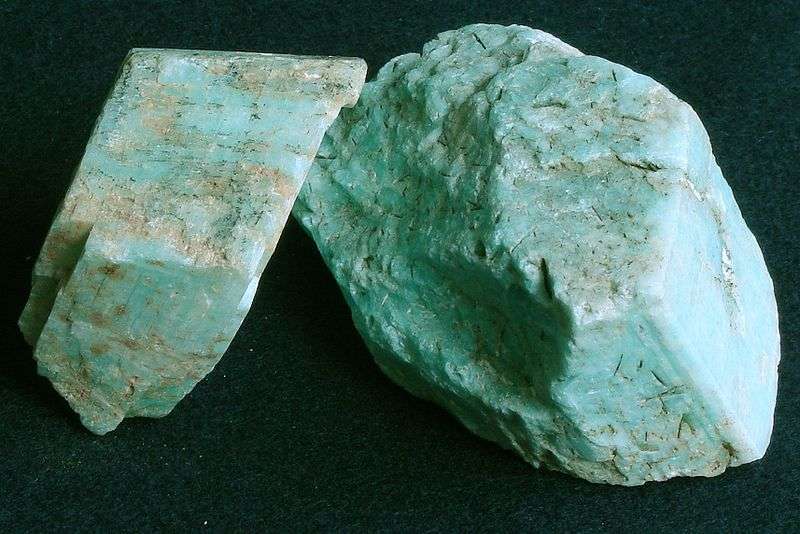
Appearance
Gemstones of extraordinary beauty, amazonite is prized for its alluring blue-green hue. Its distinctive color combination, which ranges from light turquoise to deep blue-green and frequently resembles the colors of the tropical rainforest and the Amazon River—hence its name—belongs to the feldspar mineral group.
Geographical Distribution
There are deposits of amazonite across the world, notably in Madagascar, Brazil, Russia, and the United States.
History
For its beauty and therapeutic properties, amazonite has long been valued. It is thought that this light green mineral rock dates back to the tenth century BC. Amazonite, sometimes referred to as the “Amazon stone,” was supposedly found in the Brazilian Amazon River Basin.
Metaphysical Properties
The calming and soothing powers of amazonite are said to exist in metaphysical and New Age belief systems. It is frequently linked to encouraging harmony, balance, dialogue, and emotional healing. Amazonite is sometimes used as a healing or meditation stone.

Chemical Composition
Amazonite, sometimes referred to as amazonstone, is a green tectosilicate mineral that is a microcline-type potassium feldspar. Its chemical formula, KAlSi3O8, is orthoclase-polymorphic.
Types
Amazonite Palm Stone
To fulfill a variety of functions, crystals are fashioned and sliced into various shapes. Anyone who wishes to hold a crystal in their palm while prayer or meditation is meant to use a palm stone. These stones have always been polished out and are typically rather flat. They resemble the kind of stones you could skip over a body of water.
Amazonite Granite
Sometimes, amazonite granite is used interchangeably with the amazonite countertops that we discussed previously in this article. The majority of the enormous slabs of granite that we see in homes initially originated from amazonite, which is regarded as a type of granite in Brazil. For these stones, Brazil has a substantial export market, and happily, there is an abundance of amazonite available for shipment worldwide.
Amazonite Feldspar
One term that you may frequently hear used in relation to amazonite is feldspar. According to science, the mineral amazonite is a tectosilicate. This indicates that it is a type of potassium feldspar known as microcline. Any mineral formation made of potassium, sodium, or calcium is referred to as feldspar. Other minerals on Earth that contain feldspar are labradorite and moonstone.
Flower Amazonite
Flower amazonite is the term typically used when amazonite acquires additional inclusions and colors. These stones are just different in look from the standard greenish blue kind, but other than that, there is nothing distinctive about them.
Pink Amazonite
According to certain conditions, amazonite can acquire specific mineral inclusions that enable it to display pink ray energy. This simply serves to enhance the stone’s aesthetic appeal to individuals who are drawn to pink tones. Nevertheless, some devoted crystal users assert that pink amazonite has a stronger connection to the heart chakra than typical bluish green could ever hope to have.
Uses
Amazonite’s distinctive qualities and enticing color have made it valuable and useful for a variety of uses throughout history. The following are some of the main functions and uses of amazonite:
- Jewelry: Creating jewelry is one of the most popular uses for amazonite. For usage in necklaces, bracelets, rings, earrings, and pendants, it is frequently cut into cabochons, beads, and faceted gemstones. Its vivid blue-green hue gives jewelry pieces a hint of elegance and individuality.
- Ornamental Carvings and Sculptures: Amazonite is a highly sought-after material for ornamental carvings and sculptures due to its appealing color and visual appeal. Its inherent beauty can be showcased by carving it into elaborate designs, figures, and ornamental items.
- Beads and Rosaries: Jewelry designers frequently use amazonite beads to create beaded necklaces and bracelets. Because of its relaxing color and associations with calming energies, amazonite is a popular material to use when crafting prayer and meditation beads.
- Home Décor: Amazonite is used to make ornamental objects for homes, including bowls, vases, sculptures, and other artwork. Its distinctive color can provide interior spaces a splash of charm inspired by nature.
- Fashion Accessories: Due to its distinctive color, amazonite is a popular material for hairpins, belts, and brooches.
Table





